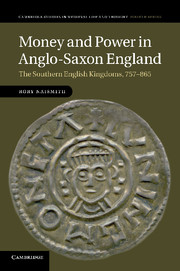Book contents
- Frontmatter
- Contents
- Figures
- Maps
- Tables
- Acknowledgements
- Abbreviations
- Chapter 1 Introduction
- Chapter 2 Money in its political context
- Chapter 3 Looking at coinage: iconography and inscriptions
- Chapter 4 Authority and minting I: the king
- Chapter 5 Authority and minting II: mints, die-cutters and moneyers
- Chapter 6 Value judgements: weight and fineness
- Chapter 7 Production of coinage
- Chapter 8 The circulation of coinage
- Chapter 9 The nature of coin-use in the early Middle Ages
- Chapter 10 Conclusion
- Bibliography
- Index
Chapter 1 - Introduction
Published online by Cambridge University Press: 07 October 2011
- Frontmatter
- Contents
- Figures
- Maps
- Tables
- Acknowledgements
- Abbreviations
- Chapter 1 Introduction
- Chapter 2 Money in its political context
- Chapter 3 Looking at coinage: iconography and inscriptions
- Chapter 4 Authority and minting I: the king
- Chapter 5 Authority and minting II: mints, die-cutters and moneyers
- Chapter 6 Value judgements: weight and fineness
- Chapter 7 Production of coinage
- Chapter 8 The circulation of coinage
- Chapter 9 The nature of coin-use in the early Middle Ages
- Chapter 10 Conclusion
- Bibliography
- Index
Summary
At every turn in the four or five hundred years before 1066 historical questions arise which are illustrated and sometimes, perhaps, are happily brought nearer solution when they are brought into connection with the numismatic evidence.
Such was the opinion of Sir Frank Stenton on the evening of 23 April 1958, when he addressed the British Numismatic Society and brought the best of pre-Conquest historical research into contact with the numismatic community. Since then coinage has remained close to the forefront of historical assessments of Anglo-Saxon England, and the special relationship between numismatists and historians continues to flourish. It is as a result of this relationship that this book came to be written: it presents not a numismatic study as such, but an exercise in the use of numismatic and monetary material in order to draw conclusions of wider historical significance. This approach has few precedents, in that although coinage is widely recognized for its significance as a historical source, rarely has it been the primary focus of historical research. More commonly coins have been drawn on by historians and archaeologists as a supplement to other material, with less focus on the potential advantages or insights that coinage has to offer on its own terms. These studies have tended to approach the coinage from one of two perspectives: that of trade, exchange and the activity of the economy; or that of government and administration. Only occasionally have the two themes been broached side by side.
To a large extent such a break is justifiable, and is grounded in the different aims, agendas and experiences of those involved in the patronage of minting, the production of coinage and in its subsequent use as currency. Yet separating the functions of coinage in this way, and divorcing them from the specifics of numismatic detail, can conceal some of the coinage’s most interesting contributions. The central aim of this book is to bring these traditions together and combine them with conclusions drawn from exhaustive and up-to-date study of the raw numismatic material – above all a complete catalogue of all 4,000 surviving specimens of gold and silver English coinage produced outside Northumbria in the period 757–865. More than half of this total has come to light only within the last four decades, making a renewed investigation of the coinage long overdue. This large corpus can be used to home in on important aspects of the coinage, such as how many sets of minting stamps (dies) were used and hence (after some statistical acrobatics) the probable productivity of different mints at different times, as well as the contributions of individual moneyers and the distribution of single-finds and hoards. Results drawn from this corpus lie, implicitly or explicitly, behind all of the conclusions presented here.
- Type
- Chapter
- Information
- Money and Power in Anglo-Saxon EnglandThe Southern English Kingdoms, 757–865, pp. 1 - 12Publisher: Cambridge University PressPrint publication year: 2011



